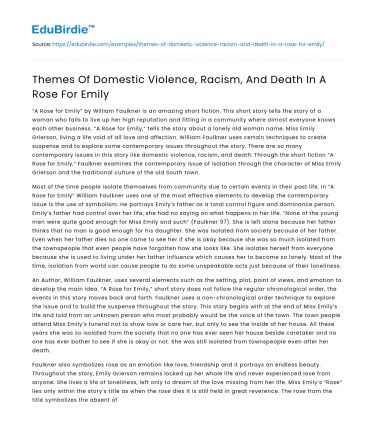“A Rose for Emily” by William Faulkner is an amazing short fiction. This short story tells the story of a woman who fails to live up her high reputation and fitting in a community where almost everyone knows each other business. “A Rose for Emily,” tells the story about a lonely old woman name, Miss Emily Grierson, living a life void of all love and affection. William Faulkner uses certain techniques to create suspense and to explore some contemporary issues throughout the story. There are so many contemporary issues in this story like domestic violence, racism, and death. Through the short fiction “A Rose for Emily,” Faulkner examines the contemporary issue of isolation through the character of Miss Emily Grierson and the traditional culture of the old South town.
Most of the time people isolate themselves from community due to certain events in their past life. In “A Rose for Emily” William Faulkner uses one of the most effective elements to develop the contemporary issue is the use of symbolism. He portrays Emily’s father as a total control figure and dominance person. Emily’s father had control over her life, she had no saying on what happens in her life. “None of the young men were quite good enough for Miss Emily and such” (Faulkner 97). She is left alone because her father thinks that no man is good enough for his daughter. She was isolated from society because of her father. Even when her father dies no one came to see her if she is okay because she was so much isolated from the townspeople that even people have forgotten how she looks like. She isolates herself from everyone because she is used to living under her father influence which causes her to become so lonely. Most of the time, isolation from world can cause people to do some unspeakable acts just because of their loneliness.
Save your time!
We can take care of your essay
- Proper editing and formatting
- Free revision, title page, and bibliography
- Flexible prices and money-back guarantee
An Author, William Faulkner, uses several elements such as the setting, plot, point of views, and emotion to develop the main idea. “A Rose for Emily,” short story does not follow the regular chronological order, the events in this story moves back and forth. Faulkner uses a non-chronological order technique to explore the issue and to build the suspense throughout the story. This story begins with at the end of Miss Emily’s life and told from an unknown person who most probably would be the voice of the town. The town people attend Miss Emily’s funeral not to show love or care her, but only to see the inside of her house. All these years she was so isolated from the society that no one has ever seen her house beside caretaker and no one has ever bother to see if she is okay or not. She was still isolated from townspeople even after her death.
Faulkner also symbolizes rose as an emotion like love, friendship and it portrays an endless beauty. Throughout the story, Emily Grierson remains locked up her whole life and never experienced love from anyone. She lives a life of loneliness, left only to dream of the love missing from her life. Miss Emily’s “Rose” lies only within the story’s title as when the rose dies it is still held in great reverence. The rose from the title symbolizes the absent of love. Since she was isolated from the world, she denied the reality of change. Emily was denied her rose, first by her father, then by the society, and then by Homer Barron.
In “A Rose for Emily” by William Faulkner, he successfully carries out the central idea throughout the story, the idea of being lonely and being isolated from society.
Work Cited
- Faulkner, William. “A Rose for Emily.” Literature: An Introduction to Reading and Writing, edited by Edgar V. Robert and Robert Zweig, 6th ed., Pearson, 2015, pp.96-101.






 Stuck on your essay?
Stuck on your essay?

